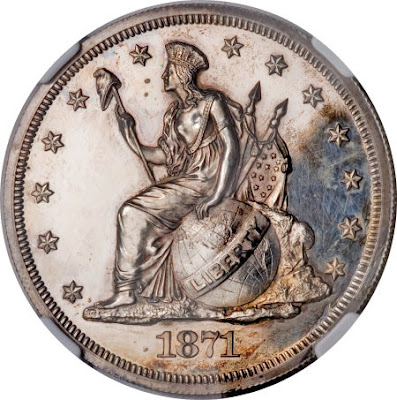 May 29
May 29Posted by John Dale
(Is it Friday already? What? Who am I? What am I doing here?... yes, it’s been one of those kinds of weeks, with the holiday at the beginning bringing it commensurate respite from labor that always has to be made up on the back end. It doesn’t get any more back end than Friday, so John Dale – always the valiant blogger – has volunteered to anchor the weekend with another of his coin posts… If he keeps this up I’ll just have to reserve Monday and Friday as coin days for our young numismatist… Today he tackles a rather humorous subject in terms of coins, and yes coins can be humorous. Just read on and you’ll see… and have a good weekend. My thanks to John Dale. – Noah Fleisher)
For more than 60 years, the highest denomination of U.S. currency printed has been the $100 bill, and despite the presence of larger notes in other denominations (such as the $500 note), the Treasury department has no plans to print anything higher. Interestingly, the largest coin struck by the United States also bears the $100 denomination: the one-ounce platinum American Eagle, represented by this 2007-dated proof specimen in our upcoming July 8-12 Summer FUN auction.
This status is subject to a couple of caveats: The first is the possibility that 2008 was the last year for the denomination. While all fractional platinum American Eagles and the uncirculated-finish one-ounce piece were discontinued after 2008, the proof one-ounce platinum American Eagle was spared, and though a release date has not been announced, I’ll mark $100 down as a “dead” coinage denomination only if I see an official statement about its cancellation or if none are minted before January 1, 2010. Until then, it counts!
Another potential quibble is that the one-ounce platinum American Eagles were never intended for circulation, from which the idea springs up that their $100 denomination shouldn’t count. It’s true that the coins were not meant to be spent; to quote from American Eagle Platinum Bullion Coins, a U.S. Mint brochure printed in March 2004, “Their face values are largely symbolic, because platinum’s market price … has historically been higher.”
The same brochure, however, emphasizes that the platinum American Eagles are real coins with the full backing of the U.S. government, specifically their “weight, content, and purity.” The standard term is non-circulating legal tender, abbreviated NCLT, but the Treasury emphasizes the legal tender aspect. (It’s worth noting that the American Eagles, like other bullion pieces struck by governments worldwide, are official coins to give them protection under anti-counterfeiting laws, in addition to other applicable statutes.)
The one-ounce platinum American Eagle may be the largest coin the United States has ever struck, but it’s hardly the largest-denomination coin ever produced. In 2004, the Austrian Mint created 15 examples of its popular Vienna Philharmonic coin in an oversized format containing 1000 troy ounces of pure gold in a .9999 fineness alloy, with a face value of €100,000.
Three years later, the Royal Canadian Mint claimed the world record. It produced a mammoth Maple Leaf bullion coin that contains an astounding 3215 troy ounces or 100 kilograms of .99999 fineness gold. Its official denomination: C$1,000,000. The Royal Canadian Mint has filled multiple orders for the million-dollar coin, though the publicity the coin has garnered has doubtless outweighed any actual profit made; as written on the Web site, “Why did the Royal Canadian Mint make the world's purest and largest gold bullion coin? Because we can.”
Until Heritage’s World Coin department gets one of those million-dollar Canadian coins in a consignment, our bidders will have to content themselves with something…smaller. Might I suggest an ounce of platinum?
Click on the title of this post to leave a comment.
-John Dale Beety
























